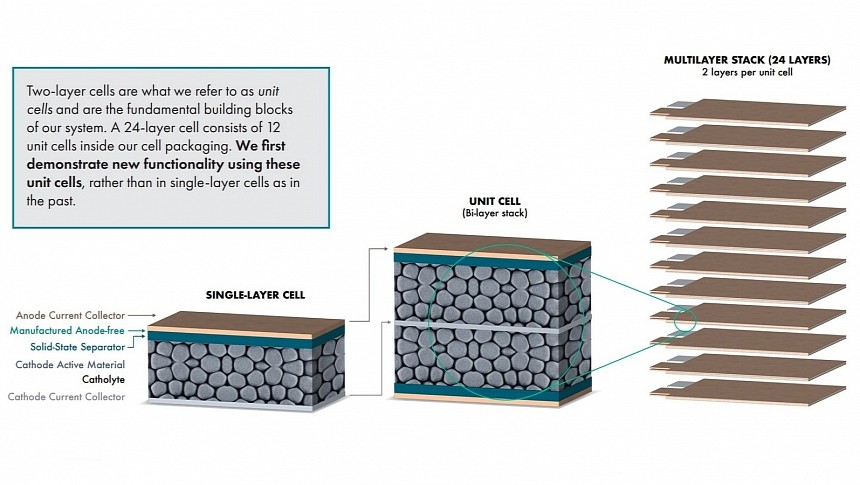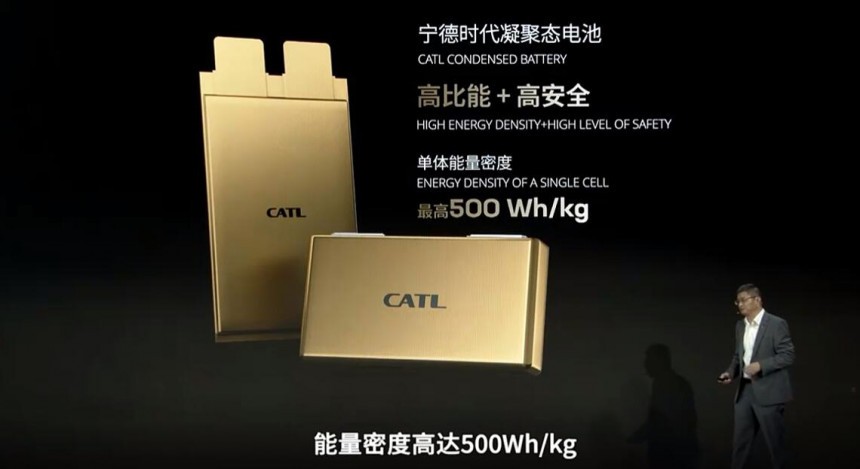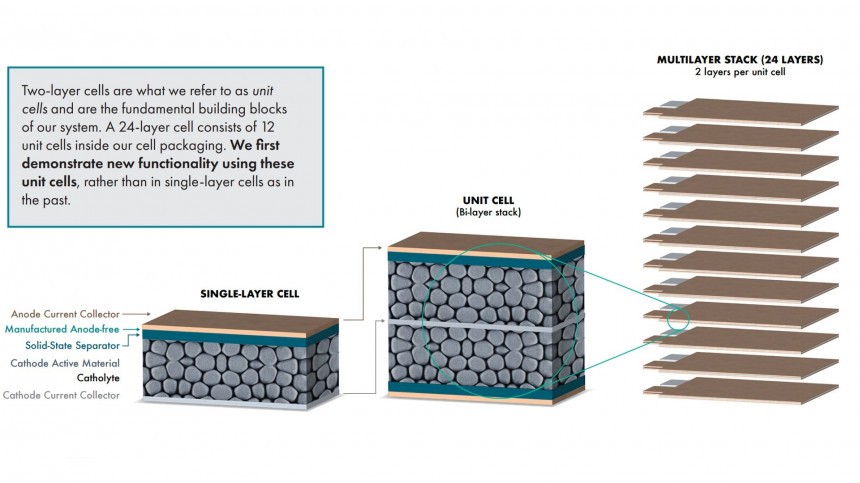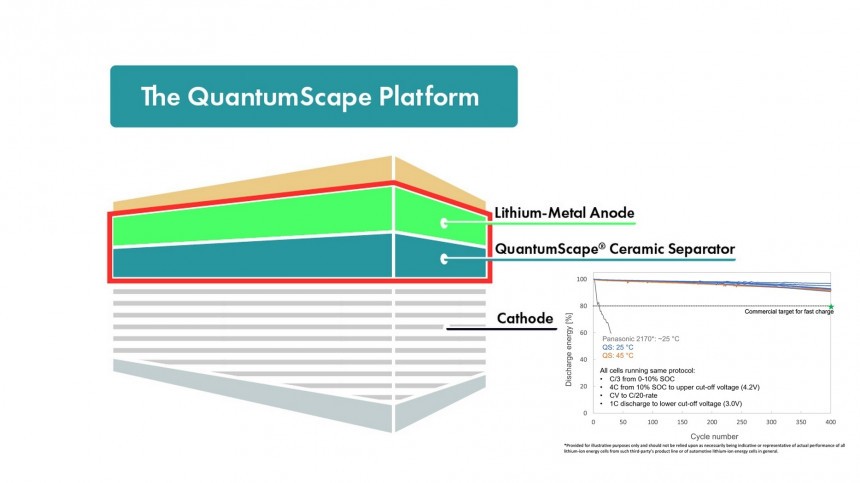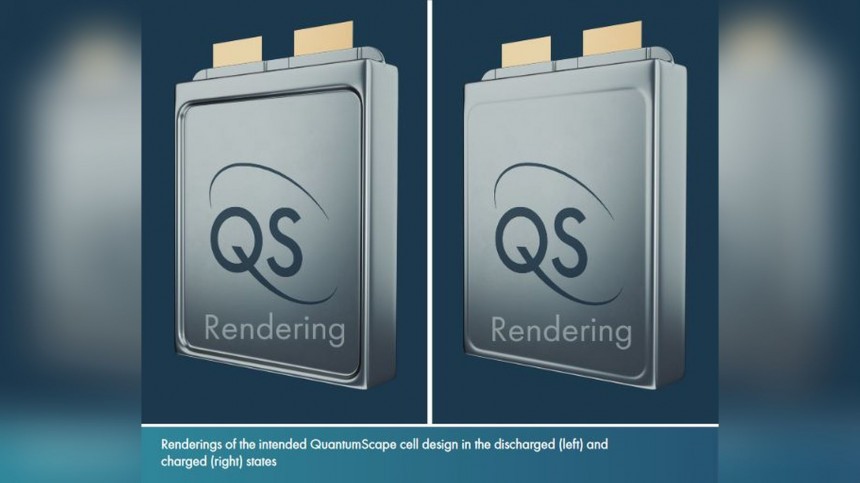QuantumScape released a letter to its stockholders in which it shared some good news. Its A0 cells behaved as expected in tests with automakers and consumer electronics companies. However, it may have bigger things to fear other than its own development process. CATL's condensed cells pose quite a threat to the startup's solid-state battery.
CATL disclosed that its new cells have an energy density of around 500 Wh/kg, which will allow a 100-kWh battery pack to weigh only 200 kilograms (441 pounds). So far, we have no idea how that compares to QuantumScape's solid-state platform because the startup has never revealed the energy density its lithium metal batteries will offer.
All we know is that it wants its first commercial batteries to present 24 layers and 5 Ah each. A 2170 cell used by Tesla in a Model 3 or a Model Y has around the same energy charge. However, it should present a higher energy density. The problem is that it may not matter if it takes too long to reach a commercial version.
The battery startup cannot rush its development pace. Although its cells went well in the tests from their potential customers, QuantumScape did not hide that it needs to improve the reliability of its solid-state batteries. This is probably why it phrased the results of its tests so carefully. According to the company, "most cells performed very well" (not all), "generally showing good cycling capacity retention and high Coulombic efficiency" (not always).
QuantumScape thinks the problem lies in eliminating defect possibilities. One example was a material used during the separator heat treatment step. The startup discovered that it increased particle contamination and decided to replace it with something else, less subject to that issue. The first results show fewer particle counts and more quality and consistency in the separator, which is a critical element of QuantumScape's anode-free lithium metal solid-state cell. Being such an essential piece of its solid-state platform, the startup developed a fast production process for it.
The solid-state battery startup also shared more technical details about its A0 cells. Their 24 layers are composed of 12 two-layer unit cells. QuantumScape is also testing them with higher cathode loading: instead of 3 mAh/cm2, 5 mAh/cm2. The startup reported that these cells endured more than 800 cycles at room temperature and a speed of 1C (a full charge in one hour). In other words, the higher cathode loading did not change the performance that these cells presented with 3 mAh/cm2. More than that, the tested cells showed sustained discharge rates of 5C at 25ºC (77ºF) and 8C at 45ºC (113ºF). In a 100-kW battery pack, that's equivalent to 700 kW.
The A0 cells that passed its tests with an automotive partner most certainly were evaluated by Volkswagen. They are just the first prototype stage. QuantumScape mentioned it would manufacture B-samples this year. C-samples are the ones that take care of validation and certification, while D-samples are in charge of the final manufacturing details. This shows how QuantumScape still has a lot to go through before its solid-state cells are available for customers.
CATL said its condensed cells would be ready for production by the end of 2023. QuantumScape was working to have a commercial version of its cells in 2024 in the best-case scenario and 2025 in the worst. The main difference is that QuantumScape's premiere will probably happen with Volkswagen, while CATL still has to find buyers for the condensed cells. It should not be hard for the world's largest cell manufacturer. Expect a Chinese company to be the first one to have these batteries. Geely's involvement may allow Volvo, Polestar, smart, or Lotus to be among the first brands with condensed cells.
QuantumScape developed a new proprietary format for its solid-state cells. It has a single expandable element, which reminds me of a cookie can without a lid. When the lithium metal layer develops, the battery expands 1 millimeter. When it discharges, the lithium layer disappears. The battery startup did not disclose if this proprietary form factor performed as expected with the companies that tested the new cells – not mentioning that anywhere in the letter to shareholders is probably good news.
Some may argue that there's room for everybody in this business and that the more new battery developments, the better. Sure, but pioneers tend to have a precious headstart that can put them into a leading position should they seize it. QuantumScape was considered the leader in solid-state cell development for quite a while, beating its closest competitors in at least three years. CATL's condensed cells are of the semi-solid-state kind, like SES, but the Chinese giant never announced development efforts: it just presented its energy density and plans to offer it to cars and airplanes. Whatever QuantumScape has to offer, it would better be superior to what CATL will be already selling.
All we know is that it wants its first commercial batteries to present 24 layers and 5 Ah each. A 2170 cell used by Tesla in a Model 3 or a Model Y has around the same energy charge. However, it should present a higher energy density. The problem is that it may not matter if it takes too long to reach a commercial version.
QuantumScape thinks the problem lies in eliminating defect possibilities. One example was a material used during the separator heat treatment step. The startup discovered that it increased particle contamination and decided to replace it with something else, less subject to that issue. The first results show fewer particle counts and more quality and consistency in the separator, which is a critical element of QuantumScape's anode-free lithium metal solid-state cell. Being such an essential piece of its solid-state platform, the startup developed a fast production process for it.
The A0 cells that passed its tests with an automotive partner most certainly were evaluated by Volkswagen. They are just the first prototype stage. QuantumScape mentioned it would manufacture B-samples this year. C-samples are the ones that take care of validation and certification, while D-samples are in charge of the final manufacturing details. This shows how QuantumScape still has a lot to go through before its solid-state cells are available for customers.
QuantumScape developed a new proprietary format for its solid-state cells. It has a single expandable element, which reminds me of a cookie can without a lid. When the lithium metal layer develops, the battery expands 1 millimeter. When it discharges, the lithium layer disappears. The battery startup did not disclose if this proprietary form factor performed as expected with the companies that tested the new cells – not mentioning that anywhere in the letter to shareholders is probably good news.
